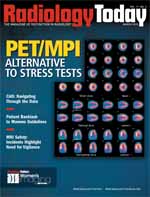 March 2010
March 2010
Catalyst
By Jim Knaub
Radiology Today
Vol. 11 No. 3 P. 7
For the past 20 years, my professional office has been located at the intersection of journalism and medicine. I have tremendous respect for both and sometimes fancy myself as having a sort of dual citizenship in both of these very different countries. But that’s not really true; I’m a journalist with some experience and understanding of the medical world.
Congress and the FDA recently weighed in on the issue of reducing the radiation dose that comes with many diagnostic imaging procedures and image-guided treatments. Congress has held hearings and the FDA is holding a meeting on March 30 and 31 to solicit comments. Credible media reports detailing serious radiation overexposure in both diagnostic imaging and radiation therapy certainly are part of the reason Congress and the FDA are publicly taking on the exposure issue right now. Powerful journalism in The New York Times, led by Walt Bogdanich, reported—in separate feature stories over the course of a year—on lethal radiation therapy overdoses, including a toddler who received 151 CT scans in 65 minutes and more than 90 patients who received improper prostate brachytherapy treatments.
Bogdanich’s work prompted the American Society for Radiation Oncology (ASTRO) to review its existing radiation therapy quality control policies. ASTRO subsequently came out with a six-point plan to improve training and safety, reported in this issue. In Bogdanich’s article highlighting the plan, ASTRO President Anthony L. Zietman, MD, noted that public awareness created by the coverage “forces us to improve our QA and our training.”
That is as it should be.
Good reporting in the public interest acts as a catalyst. The radiation oncology community would have preferred that such a review and change would have occurred naturally and quietly over time. But history suggests that such uncomfortable scrutiny often makes necessary change happen sooner. That seems to be the case now.
People make mistakes and processes can fail. The best response is to minimize the damage and do what you can to prevent the mistakes from happening again. One of the best ways to measure individuals, organizations, and communities is how they respond to the mistakes they inevitably make. I’m confident the radiology and radiation therapy community will respond well.
Enjoy the issue.
jknaub@gvpub.com

